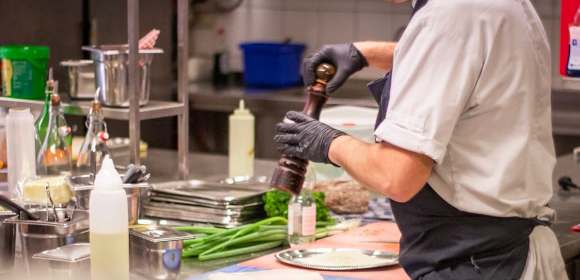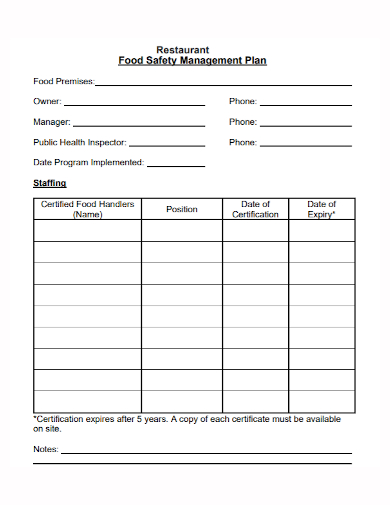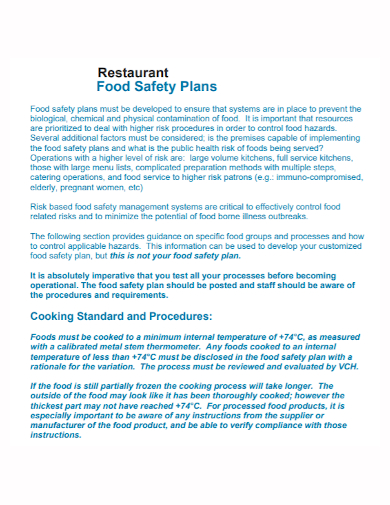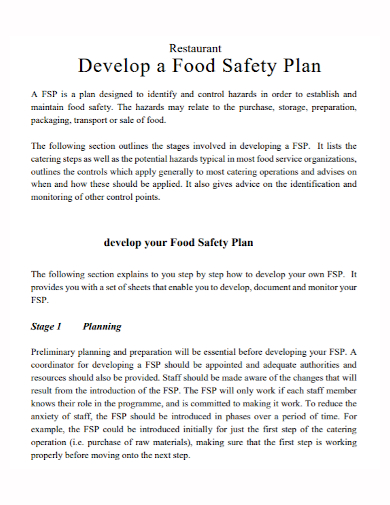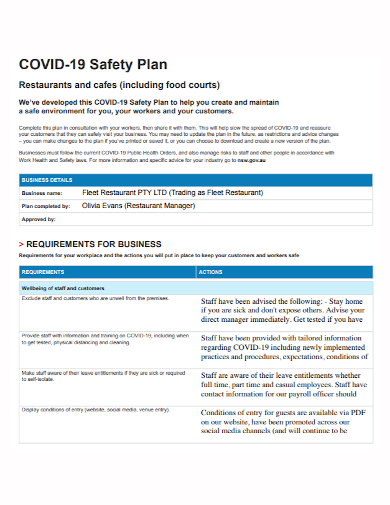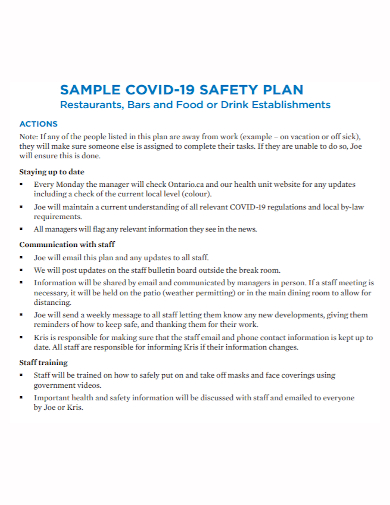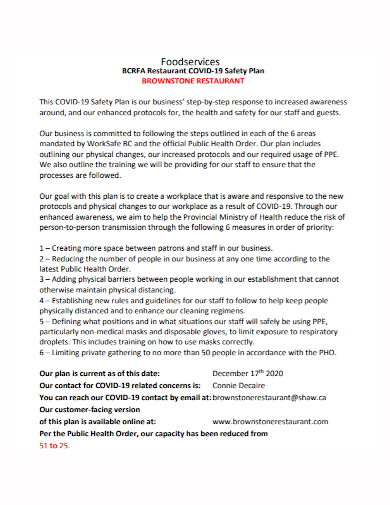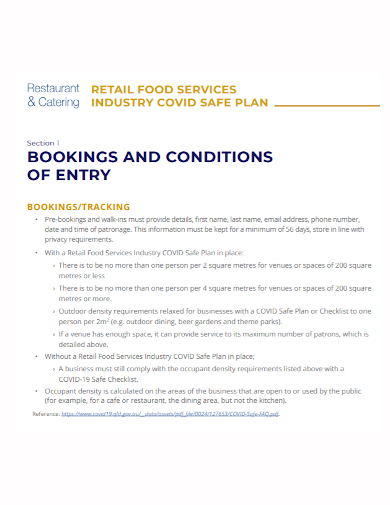When you’re running a restaurant, it’s important to ensure that the food you prepare is safe to consume for everybody. The last thing you need is facing legal matters due to unfortunate circumstances that happen in your restaurant such as having a guest getting food poisoning or having some foreign objects in the food that you’re serving that could hurt your guests if they swallow or ingest it. To help you prevent these things, a food safety plan is essential to use as your guidelines for your staff in following safety protocols to prevent those risks. The safety plan can also be used as your standard operating procedure to ensure the quality of your food. Read the article to know how to make a food safety plan.
10+ Restaurant Food Safety Plan Samples
1. Restaurant Food Safety Plan Template
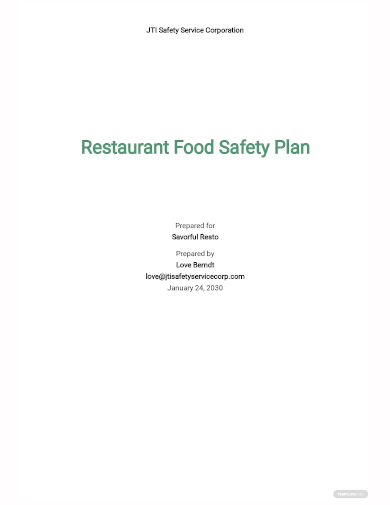
2. Restaurant Food Safety Management Plan
3. Restaurant Food Safety Plan
4. Restaurant Food Safety Business Plan
5. Sample Restaurant Food Safety Plan
6. Restaurant Development Food Safety Plan
7. Restaurant Food Court Safety Plan
8. Restaurant Food Establishment Safety Plan
9. Restaurant Bar Food Safety Plan
10. Restaurant Food Services Safety Plan
11. Restaurant Catering Food Safety Plan
Importance of Food Safety
Food safety is important to ensure that the food that is being handled and produced is safe for consumption. Taking food safety for granted raises the risk of contamination from harmful pathogens that can cause foodborne diseases and food poisoning that can be fatal to a person’s health.
How to Make a Restaurant Food Safety
1. List All Food Hazards
A food hazard is anything that may cause a food to be dangerous for humans to consume. To create a food safety plan, you need to identify all hazards for you to think up ways to prevent and mitigate them. Some examples of food hazards are:
- Raw materials containing harmful micro-organisms
- Cooked food obtaining harmful toxins due to the way it was prepared
- Food containing harmful chemicals
- Food containing harmful physical objects such as pieces of metal or glass shards
2. List All Preventive Measures
The next step is to write down all the measures and their control limits (the value or measurement of food that must be achieved such as its temperature or acidity to ensure its safety) that can be used to control all the food hazards you listed. Some examples of preventive measures are:
- Using reputable and trustworthy suppliers
- Having adequate freezing or chilling temperature for food storage
- Using proper ways to thaw frozen foods
- Cooking food thoroughly
3. Create Monitoring Procedures
When you create monitoring procedures for your preventive measures and their control limits will ensure that any type of out-of-control situation can be identified to ensure that corrective actions can be taken before the becomes unsafe to consume. Make sure that the procedures should be easy to follow by staff by setting clear instructions. Below are some examples of monitoring procedures:
- Measuring cooking temperature and its time to get to the right temperature
- Inspecting the notice of “use by” date and stock rotation of food
- Observing the cleanliness of equipment used in handling food and work surface
- Inspecting all incoming food ingredients and produce
4. Create Corrective Actions
Sometimes mistakes or accidents happen so you need to think up corrective actions to mitigate the consequences from escalating even further. Make sure these actions must be possible to be done immediately. Some examples of corrective actions are:
- Reheat the food until its core temperature reaches a certain point in a particular number of seconds or minutes if the cooking temperature happens to be inadequate.
- Adjust or repair the chiller or freezer if its temperature is higher than the required chilling/freezing point.
- Clean the equipment if they are dirty.
5. Keep Monitoring Records
To keep track of your work, make sure to maintain monitoring records that help evaluate whether preventive measures are adequate and efficient enough to use as a standard procedure or not.
FAQs
What are the five keys to food safety?
The five keys of food safety are:
The food must be kept clean at all times, raw food and cooked food must be kept separated, it must be cooked thoroughly, keep it at safe temperatures, and it should be prepared using safe and clean water and materials.
Who needs a food safety plan?
The Food Safety Modernization Act 2010 (FDA) requires that all other food processing businesses must prepare a food safety plan.
Before you print the final and official copy of the food safety plan you’re going to use for your restaurant, make sure to check it and review it for any grammatical errors or inaccurate details. Ask a colleague to help you out in the editing process. To help you get started on writing the safety plan, download our free sample templates above to use as your guide!
Related Posts
FREE 7+ Fashion Business Plan Samples in PDF
FREE 10+ Sprint Planning Samples In MS Word | Google Docs | PDF
FREE 10+ Wedding Planning Samples in MS Word | Apple Pages | Powerpoint | PDF
FREE 9+ Monthly Study Planner Samples in PSD | Illustrator | InDesign | PDF
FREE 9+ Sample Curriculum Planning Templates in PDF | MS Word
FREE 10+ Teacher Development Plan Samples in MS Word | Google Docs | Apple Pages | PDF
FREE 10+ Basketball Practice Plan Samples in PDF
FREE 12+ School Business Plan Samples in PDF | MS Word | Apple Pages | Google Docs
FREE 7+ Client Strategic Plan Samples in PDF | MS Word
FREE 11+ Trucking Business Plan Templates in PDF | MS Word | Google Docs | Pages
FREE 7+ Small Hotel Business Plan Samples PDF | MS Word | Apple Pages | Google Docs
FREE 14+ Bakery Business Plans in MS Word | PDF | Google Docs | Pages
FREE 4+ Yearly Lesson Plan Samples in PDF
FREE 50+ Strategic Planning Samples in Google Docs | Pages | PDF | MS Word
FREE 10+ Construction Project Plan Samples in MS Word | Google Docs | Apple Pages | PDF
